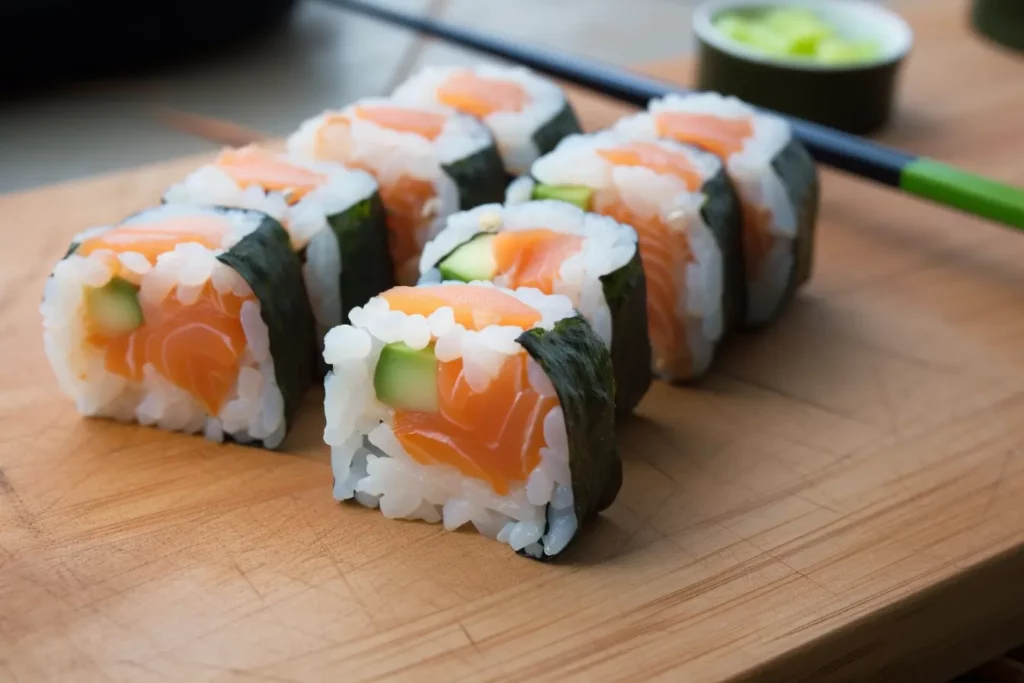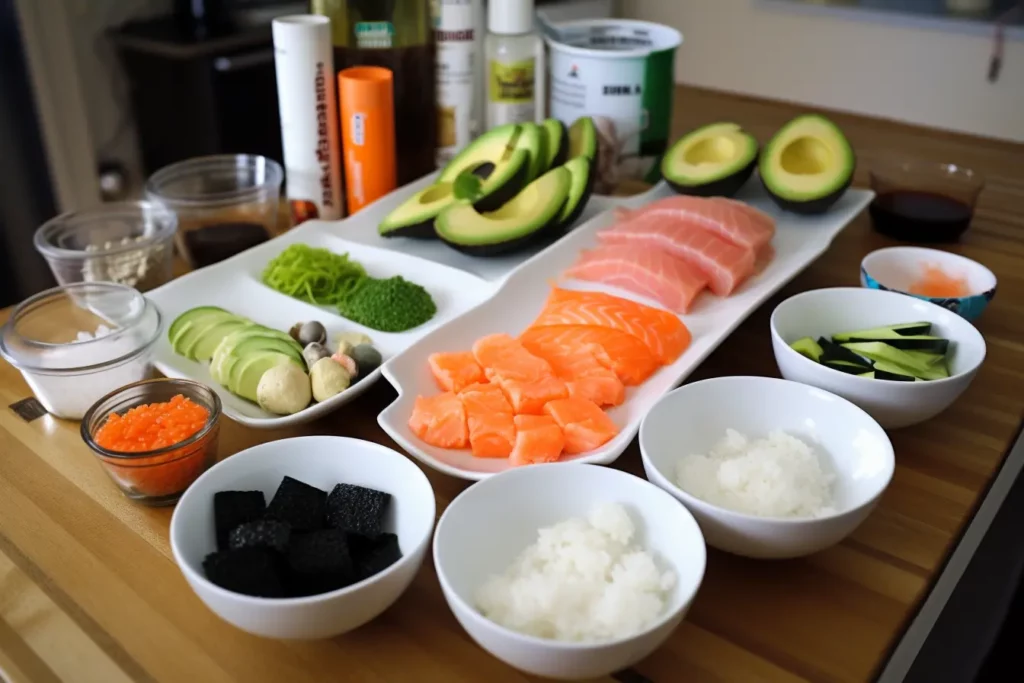The art of making sushi requires patience, precision, and an eye for detail. However, these techniques are not exclusive to master chefs. With the right guidance and practice, even enthusiasts or home cooks can create tasty and beautiful sushi rolls. In this guide, we’ll explore the art of making the perfect sushi rice and discover different techniques for rolling and shaping sushi. In addition, we will learn how to choose fresh fish, cut vegetables and prepare other traditional or creative fillings for sushi recipes.
Preparing the Perfect Sushi Rice
One of the most important aspects of an exquisite sushi experience is undeniably the perfect sushi rice. If it’s done well, it skilfully brings flavour and texture together and lifts a simple sushi up to the sky.
Smooth texture and subtle taste, the perfect sushi rice really only needs an exquisite interplay of a few but high-quality ingredients and a little patience. As with anything precious, it takes time, persistence, and attention to detail to get it right.
Let’s start by choosing the right rice. For sushi, you should always use the so-called Shari rice, a special short- to medium-grain short-grain rice. It has the ideal consistency and absorbs tastes excellently.
The first step is to wash the rice to remove excess starch. Rinse under running water for about seven to ten minutes until the water runs clear. Then drain the rice and let it rest for about 30 minutes.
To cook the rice, add 1 cup of rice to a saucepan with 1.2 cups of water and bring to a boil. Once the water is boiling, reduce the heat and cover the pot. Let the rice cook for 10 minutes, then remove from the heat and let it rest for another 10 minutes.
In the meantime, prepare the seasoning mix by boiling rice vinegar, sugar and salt in a saucepan and then letting it cool.
After the rice has cooled, add the seasoning mixture and stir it into the rice carefully. Make sure each grain of rice is evenly coated.
Don’t forget to hone your craft. The more often you make sushi rice, the better you’ll get. But most of all, enjoy the process and the delicious end result. The perfect sushi rice is truly a work of art and once mastered, it opens the door to a variety of exquisite sushi creations.
Truly, the art of making the perfect sushi rice is a valuable skill that requires time, effort, and dedication, but it’s also one of the most rewarding.

Proper rolling and shaping of sushi
The Art of Rolling and Shaping Sushi Correctly
After getting comfortable with the mastery of the perfect sushi rice, you can turn to the art of rolling and shaping. Understand that the shape and size of the sushi are just as important as the taste to provide an unforgettable dining experience.
A carefully rolled and properly shaped sushi speaks volumes about your sense of aesthetics and attention to detail. Therefore, it is important to learn how to roll and shape sushi to create a complete and aesthetically pleasing dish.
At first, you may think it’s complicated, but with the right tools and a well-followed technique, you’ll realize that creating your role really is a breeze. An essential piece of equipment that you will need is the sushi mat, known as “Makisu” in Japanese.
- Place a piece of nori (dried seaweed) on the flat side of the maki and spread a thin layer of your perfect sushi rice on top of the nori, but leave about an inch of nori free at the top. This allows for a clean seal of your sushi roll.
- Place fillings in a line in the center of the rice to taste. Be careful, though, because less is more in this case. Overcrowding could cause your sushi roll to fall apart.
- Now comes the part where a little skill is required. With the help of the makisu, roll the nori and rice over the fillings. Try to keep the roll as tight as possible. The goal is to get a tightly packed sushi roll.
- Once the roll is completely wrapped, use the free end of the nori to seal the roll. A little water can help moisten this end and ensure sealing.
- After rolling, you can then use a sharp, damp knife to cut your roll into even pieces.
Keep in mind that shaping and rolling sushi is a process that takes practice and patience to master. So don’t be discouraged if your first few attempts aren’t perfect. With time and practice, you will surely progress and be proud of your creations.
The roll itself may be the centerpiece of the sushi, but don’t forget to serve the whole thing with unique and delicious side dishes like pickled ginger, wasabi, and soy sauce. With the right presentation and attention to detail, you can give your guests a complete sushi experience.
Finally, get inspired and have fun doing it! There are no hard and fast rules when it comes to what fillings you can use or what your sushi rolls should look like. Your creations are ultimately an expression of your own creativity and taste. It’s about enjoying the process of learning and creating while delighting your taste buds and those of your guests. Bon Appétit!

Selection and preparation of sushi fillings
Once you’ve mastered the perfectionist art of sushi rolling and dedicated yourself to carefully preparing the sushi rice, you might now be curious about the next step: choosing and preparing the best sushi fillings. In fact, the fillings can make all the difference in your sushi experience, bringing an abundance of flavors, textures, and colors that make the handmade sushi a feast for the senses.
Each sushi roll ranges from the classic simple to the outlandishly exotic, and you can achieve that as long as you stick to the basic rules. The first step is to choose high-quality, fresh ingredients. This includes a variety of vegetables, fish and spices. For the fish, it’s best to opt for heavily frozen seafood products, as they can kill parasites and minimize the risk of food poisoning. Another crucial factor is the presentation of the ingredients. Always cut them into even, thin strips to ensure harmonious distribution.
Especially for beginners, it might be helpful to start with the familiar fillings—classic ingredients like tuna, salmon, avocado, and cucumber are tried-and-true favorites. Once you feel confident, broaden your horizons and experiment with other ingredients such as mango, tofu, pickled vegetables, or even luxury elements such as caviar and truffles. There are no limits to your creativity, as long as the ingredients are fresh, healthy, and appealing.
Preparing sushi fillings is almost as therapeutic and rewarding as rolling and shaping the sushi itself. Cutting each strip of ingredients and then artfully inserting them into the sushi roll is like painting a vibrant, edible piece of art. You will find that choosing and preparing the best sushi fillings is a relaxing and sensual pleasure that offers a true pleasure and reveals the real magic of sushi making.
Although there are no hard and fast rules, you should always taste, season and season again – this guarantees that your filling combinations will harmonize well and make your sushi rolls addictive. Remember that sushi embodies a balance between simplicity and sophistication, and nothing is worse than an inharmonious blend that distracts from the real star of the show – the sushi rice.
Finally, enjoy the process – as with any culinary creation, sushi-making is meant to be fun. Her energy and passion will pour into every sushi roll and her guests will feel it too. Think of each sushi roll as your personal food business card and be proud to showcase and share your sushi artwork. Have fun making sushi!

By following these guides, you’ll equip yourself with the basic knowledge you need to make great sushi at home. There is always room for creativity in the kitchen, so do not hesitate to experiment with different types of fish, vegetables or even unusual ingredients. With practice and patience, you will soon be able to make sushi that is not only delicious but also a real feast for the eyes. Enjoy making sushi and most importantly, sharing and enjoying your creations with family and friends.


